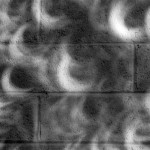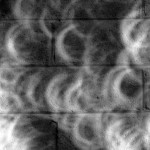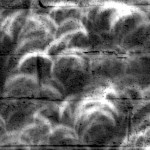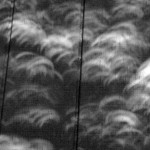I spy with my little pine: solar crescent-eye
Since we aren’t equipped to either observe or photograph solar eclipses directly, E and I took to the yard during Sunday evening’s event to seek indirect eclipse images instead. The classic pinhole method is simple and adequate — poke a small hole in foil or stiff cardboard, and let the sun shine through the hole onto another card, positioned so that a small image of the sun can be seen on the second surface: the bigger the spy-hole, the 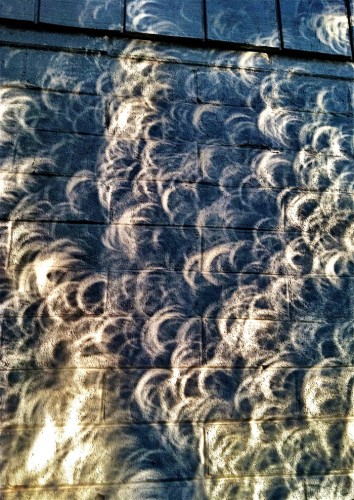 farther away the second card needs to be. This works well enough to see with your eyes, but we found the images of the sun were too vague for the clumsy auto-focus mechanisms of digital cameras to gather adequate images. Also, the scale of the card operation is tiny, and so, although interesting (and positively better than the alternatives of not seeing the eclipse or blinding yourself trying) it’s not hugely thrilling.
farther away the second card needs to be. This works well enough to see with your eyes, but we found the images of the sun were too vague for the clumsy auto-focus mechanisms of digital cameras to gather adequate images. Also, the scale of the card operation is tiny, and so, although interesting (and positively better than the alternatives of not seeing the eclipse or blinding yourself trying) it’s not hugely thrilling.
(<< multiple solar eclipses cast onto a house wall through the pine tree canopy)
Fortunately, our yard has an enormous pinhole camera growing in it: the Aleppo pine tree. Its clumped, criss-crossing needles create a fine mesh that, in addition to delightfully sifting raptors out of the wind, also results in a wonderful indirect eclipse-viewing system. The tree’s foliage-mass essentially acts as a large card with innumerable pinholes in it: the pine shadows — as well as the shadows of any other trees with sufficiently small spaces between leaves — become patches of eclipse crescents projected onto the back wall of the house, the block fence, and even the ground where the surface is smooth enough to retain detail. The apertures (the spaces between the trees’ foliage) and the focal plane (the wall, etc) are far enough apart so that the solar crescents are fairly large.
Those solar images can be readily and safely observed and  photographed with any camera, and although not as spectacular as a directly photographed astronomical image of the sun, these sun-shaped light leaks make up for their lack of solitary crispness with the sight of multitudes of bright crescents spangling whatever lies in the umbra of the trees, even E’s ASU tee shirt: Sun Devils for real! >>
photographed with any camera, and although not as spectacular as a directly photographed astronomical image of the sun, these sun-shaped light leaks make up for their lack of solitary crispness with the sight of multitudes of bright crescents spangling whatever lies in the umbra of the trees, even E’s ASU tee shirt: Sun Devils for real! >>
(By the way, trees do this pin-hole sun-image thing all the time, it’s just that the light-leaks are round like the unobstructed sun, so we call it “dappling” and consider it “normal”.)
(Above photos A.Shock)
In the following series of photos (by E.Shock), beginning at the left, you can see the progression of the moon shadow from upper right to lower left across the disc of the sun. In Phoenix, we experienced more than 80% occlusion.

